


 |
HOME

 |
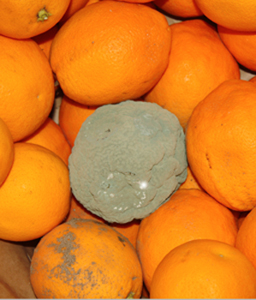
|
Keep Your Eyes Peeled |
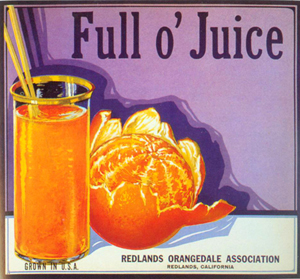
|
| Many of the Giant Orange stands have gone moldy but a few survive. |
Lots of photos. |
An orange crate label from the 1920s promoting the healthful qualities of oj. |
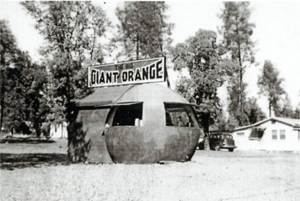 |
| The Pine Grove (aka Shasta Lake City) Orange north of Redding, CA in its humble beginnings. |
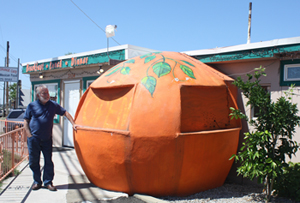 |
| The Pine Grove Orange survives as Joe's Giant Orange. |
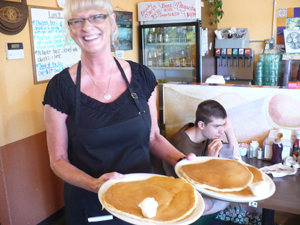 |
| Giant Pancakes from the Giant Orange. |
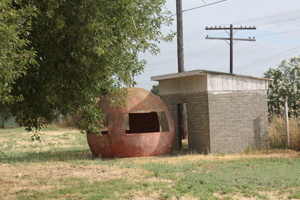 |
| Only the peel of the Giant Orange remains in Williams, CA. |
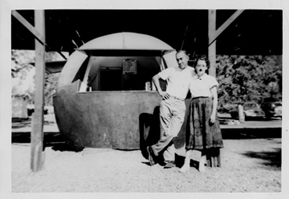 |
| George and Adelaide Castle in front of their Pine Grove restaurant after the awning was built in the late 1940s. (Thnx to Giant Orange Pledge facebook page.) |
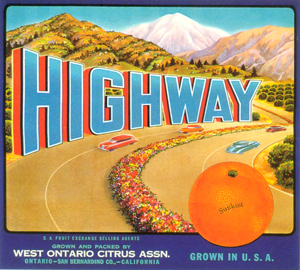 |
| Once Americans were hooked on orange juice for breakfast health was no longer the crate label focus. |
|
Perhaps you were that 1950s kid, pleading with Dad from your back seat prison to please, please, please stop the car! Just ahead, your eagle eyes caught the glint of California sunshine radiating off a Giant Orange stand, and you were dying of thirst. Or, maybe the kid was your dad, or maybe YOU were Dad. Regardless, this scenario must have unfolded thousands of times along Highway 99, for Giant Orange restaurants once lined it in a long golden chain. A few pieces of oversized citrus survived to the 21st century. As examples of “programmatic architecture”, the buildings themselves revealed the main bill of fare. In their infancy, people from all walks of life, Hollywood stars to migrant workers, lined up together to buy a glass of the sweet pulpy drink dispensed from a whimsical building. But times do change. On the heels of decades of popularity, the bright and brassy Oranges got overrun by new trends. The rise of Interstates and their freeway exit “villages” changed the way people traveled. Giant Oranges fell out of favor. Until recently. In 2009 The Society of Commercial Archeology bestowed an Endangered designation upon the few remaining orange stands, and not a day too soon. Natives of the Golden State Giant Oranges are a mainly a California phenomenon. The words “California oranges” have been linked together in the American consciousness for 100 years. Early 20th century California growers cleverly promoted orange juice as a health drink. Soon, wooden crates of oranges were being shipped all around the country. The orange displayed on the colorful box labels became the Golden State’s most recognized icon. Enter Frank Pohl. The creative California entrepreneur shaped a large globe of wood and plaster and painted it bright orange. Outfitted with a hot dog steamer and hand juicer, he opened his first Giant Orange in 1926 in Tracy, a Lincoln Highway town. Fresh-squeezed orange juice over chipped ice sold for 15¢. His earlier Giant Lemon venture met a sour end. But Frank’s Orange innovation expanded into a family-run chain that lasted for decades. Sons, brothers, sisters, in-laws, aunts, uncles and cousins all lent a hand squeezing the 6,000 oranges used at one stand in a week’s time. The family remained in the business until 1973. Frank Pohl’s great granddaughter, Janet smiles as she recalls “the wonderful smell of the oranges as they were being squeezed….the best juice ever!” But before we get too effusive about the healthful drinks offered at the stands, consider that another item on the menu in the earliest days was Cold Keg Beer. Match that, McDonald’s! The Golden Chain US99 was the major north-south route connecting the populated areas of California, and the majority of Giant Oranges occupied its roadside. Imagine 99 as a conveyer belt in a citrus packing shed. “Original” Giant Oranges would be plucked off and placed in Bakersfield, Tulare, Madera, Chowchilla, Merced, Turlock, Lodi, Galt, Sacramento and Roseville. US40 and US50 got a handful, too. Over the years, Pohl family Giant Oranges shared the roadside with a variety of knockoff cousins; Mammoth Orange, Big Orange, Great Orange, Big Boy Orange, Whoa Boy Orange and just plain The Orange. One survivor, currently empty, sits on old US66 in Fontana. But whichever their appellation, eventually additions were built onto most of the Oranges to provide more space for cooking. Subsequently, the orange part of the structure was used only for serving, or became merely a decorative feature. This is the situation at the best-preserved Orange restaurant situated near Redding, CA, 50 miles from the most northerly grove of semi-tropical citrus trees. Ironically, fresh-squeezed orange juice is not on the menu at Joe’s Giant Orange. But just about everything else is, and in giant-sized portions. The orange, now an appendage on the front of the building, looks excellent for being over 60 years old! Fortunately, earlier plans to transform the orange into a red tomato were vetoed by the city. George and Adelaide Castle built the seed of this structure in the late 1940s. During WWII George worked the shipyards in the San Francisco Bay Area. After the war, the Castles packed up their kids and migrated north to Redding. They bought a piece of land next to the highway and moved into a ramshackle shack. Then, using purchased plans, they built a Giant Orange. Franchise fees were $25 a year. It cost around $1000 to build an Orange. Curved ribs were cut of pine, plaster over lathing was on the inside and cement then stucco covered the outside, painted orange of course! It sat on skids of redwood, another California icon. There were three serving windows and a drain in the floor. Travelers coming down Highway 99 from cool Oregon, or up from foggy San Francisco wilted in the Redding heat. A frothy glass of ice-cold orange juice over chipped ice was impossible to resist. It cost 21¢. Bill and Bob Castle were raised in this Orange’s shadow. Bill remembers, “My mom would only let me have a hot dog and orange juice one time per week.” A shipment of oranges arrived by truck from LA every other week. Business was brisk, the workdays long. Triple-digit summers are the norm in Redding so the stand-alone Orange got a wooden sunshade. It later collapsed from a rare heavy snow. In 1953, a highway widening forced the family out. The Duryee family bought the Giant Orange, towed it down the road ¼ mile, and set up for business next to their gas station and trailer park. It’s still there. In Williams, 100 miles south, an empty “peel” of an Orange sits forlorn in a vacant lot. Little has been discovered about its history. It’s a wonder the little slightly off-round building has survived without serious vandalism. A close look at this barebones Orange reveals just how humble were the structures. Oranges on the Go Giant Orange design dictated they be built on skids, making them moveable. This trait was put to good use over the years. In Dixon, highway realignments caused the stand to be moved three times. An Orange in San Jose, now called Mark’s Hot Dogs, was towed over several blocks. Likewise for the Pohl’s Giant Orange in Madera, in the fertile heart of the Central Valley. In 1958, for reasons no longer remembered, the family hitched up their Madera Orange and towed it north on Highway 99 to Chowchilla. Then they built a twin across the highway. There was another set of twins just four miles away in Fairmead near a busy turnoff to the populated Bay Area. Heavy traffic here meant 99 was difficult to cross, so a second source of the popular treat was erected across the highway. This particular stretch of 99 stayed a post-war style expressway until 2008. Then, a long-planned upgrade cut off access to the surviving restaurant on the east side. “Highly agitated” would describe how travelers, truckers and locals all felt about the impending demise of their favorite eatery, the Mammoth Orange, and they raised the alarm. Glum moods lifted on a warm day in May. A skilled house-mover carefully eased one of the last remaining orange stands onto his truck bed. The truck slowly made it’s way to the Chowchilla city yard, the only entry in a history-making parade. The City of Chowchilla purchased the Orange, its future undecided. We can only hope it gets turned into some fine fruit preserves. 2014 Update. A June 16, 2013 article in the LA Times reports that, after the Giant Orange languished in the Chowchilla city storage yard for several years it was put up for bid. Paying $2050, the successful bidder was the Fossil Discovery Center, a newish museum/roadside attraction. The plan is to erect the Orange next door to the museum, just down the road from it’s original location! |